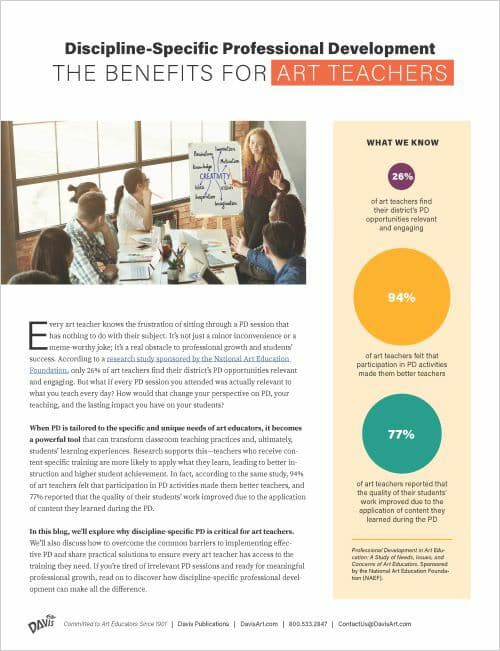The Benefits of Discipline-Specific Professional Development for Art Teachers
Every art teacher knows the frustration of sitting through a PD session that has nothing to do with their subject. It’s not just a minor inconvenience or a meme-worthy joke; it’s a real obstacle to professional growth and students’ success. According to a research study sponsored by the National Art Education Foundation, only 26% of art teachers find their district’s PD opportunities relevant and engaging. But what if every PD session you attended was actually relevant to what you teach every day? How would that change your perspective on PD, your teaching, and the lasting impact you have on your students?

When PD is tailored to the specific and unique needs of art educators, it becomes a powerful tool that can transform classroom teaching practices and, ultimately, students’ learning experiences. Research supports this—teachers who receive content-specific training are more likely to apply what they learn, leading to better instruction and higher student achievement. In fact, according to the same study, 94% of art teachers felt that participation in PD activities made them better teachers, and 77% reported that the quality of their students’ work improved due to the application of content they learned during the PD.
In this blog, we'll explore why discipline-specific PD is critical for art teachers. We’ll also discuss how to overcome the common barriers to implementing effective PD and share practical solutions to ensure every art teacher has access to the training they need. If you're tired of irrelevant PD sessions and ready for meaningful professional growth, read on to discover how discipline-specific professional development can make all the difference.
The Need for Discipline-Specific Professional Development
Art teachers face unique challenges that general PD sessions often miss. According to the NAEF survey, 12% of art teachers found PD activities irrelevant to their field. Not surprisingly, this disconnect leads to disengagement and missed growth opportunities for art educators. This reinforces the idea that PD for the sake of PD is never a good idea.
Art teachers aren't looking for generic training—32% of art teachers want more focus on curriculum development, and 25% seek deeper training in studio techniques. This makes perfect sense as these areas are vital for art educators to keep their teaching fresh and in line with new artistic trends and technologies.
Impact of Content-Specific Professional Development on Teachers
Content-specific PD has been shown to significantly enhance teaching quality. According to the NAEF report, 94% of art teachers felt that participation in PD activities made them better teachers. Furthermore, 33.87% of art teachers who engage in discipline-specific PD feel supported by their administration.
When PD is tailored to the specific needs of art educators, it becomes more than just a box to check. It equips teachers to handle their unique classroom challenges and inspires them to innovate. This specialized training not only makes teaching more effective but also creates a more engaging learning environment for students. By investing in discipline-specific PD, we can ensure art teachers feel supported and empowered, ultimately leading to better educational outcomes for their students.
Impact of Content-Specific Professional Development on Students
The NAEF report highlights the direct correlation between substantial PD and student achievement. For instance, 80% of teachers felt that their students' learning improved as a result of their professional development experiences. This demonstrates the critical role of relevant PD in boosting student success and how educators feel about their success in the classroom. When teachers are better equipped and more confident in their methods, students benefit directly through enhanced learning experiences and outcomes. This is no different for art educators.
Additionally, the U.S. Department of Education’s Institute of Education Sciences (IES) report highlights the direct correlation between substantial PD and student achievement. Teachers who received an average of 49 hours of PD saw their students' performance improve by about 21 percentile points, and teachers who receive curriculum-specific PD are more likely to adopt effective teaching practices which ultimately lead to improved student learning outcomes.
Overcoming Barriers to Effective Professional Development
Implementing discipline-specific PD in schools can be challenging due to budget constraints and lack of resources. NAEF reports that 38% of art teachers said that lack of funds was a major hindrance to their professional development. Although it may not seem fair, advocating for increased funding specifically for art education and PD is essential. Schools can partner with national and local art education organizations to access grants, scholarships, and learn about using Title funds.
Leveraging local art community resources, such arts centers or artists collectives, content providers like Davis and SchoolArts, or professional organizations such as museums and galleries can provide unique PD opportunities. Despite the challenges, research shows that schools that invest in targeted PD see improvements in teacher satisfaction and student outcomes. Teachers who receive relevant training are more confident and effective, leading to more engaging and innovative teaching practices. Addressing funding issues and providing targeted PD ensures teachers are equipped to inspire and engage their students. Investing in discipline-specific PD fosters continuous improvement, peer-to-peer learning, and a supportive professional community.
The Future of Professional Development in Art Education
Prioritizing discipline-specific professional development is essential for enhancing teaching quality and positively impacting student outcomes. When administrators and policymakers support relevant PD, they ensure that educators have the tools and knowledge needed to succeed. Investing in targeted PD benefits both teachers and students, fostering a more effective and engaging educational environment.
By addressing funding issues and leveraging community resources, schools can provide art teachers with the professional development they need to thrive. This approach not only boosts teacher confidence and innovation but also leads to improved student learning experiences. As art teachers continue to integrate new ideas and techniques into their classrooms, the overall quality of art education will rise, creating a more dynamic and effective learning community.
Ultimately, targeted professional development for art educators is a smart investment that leads to happier teachers, successful students, and a stronger educational experience.
Learn more about Professional Development options from Davis!
When PD is tailored to the specific needs of art educators, it becomes a powerful tool that can transform students’ learning experiences.
Download a printable PDF of The Benefits of Discipline-Specific Professional Development.



Comments